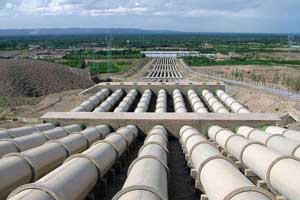Drag reducing agent is a kind of chemical that can reduce the resistance of fluid during transportation. This chemical agent used to reduce the resistance of fluid flow is called a drag-reducing agent (DRA).
Drag reducers are widely used in crude oil and refined oil pipeline transportation. It is an important way to improve the circulation capacity of the pipeline and reduce energy consumption in specific locations.
The frictional resistance of the fluid limits the flow of fluid in the pipeline. This will cause a reduction in pipeline throughput and an increase in energy consumption. The polymer drag reduction method is to inject a small amount of polymer into the fluid. Make it reduce the resistance of flow under turbulent flow.
The DRA is mostly water-soluble or oil-soluble polymer.
Water-soluble DRA polyethylene oxide. To reduce the resistance of water in the pipeline by 75% is only need 25mg/kg. The water output rate has increased several times. This kind of drag-reducing agent is mostly used for fire extinguishing or other emergency water occasions.
When the dosage of oil-soluble drag reducer polyisobutylene is 60 mg/kg, the transportation capacity of crude oil in the pipeline can be greatly improved. It can play the role of increasing transmission and energy saving.
In view of its structure, oil phase drag-reducing agents are mostly flow chains or long straight-chain polymer with few side chains. For example, CDR102 is a polymer poly-σ olefin. This high molecular polymer pure agent is a rubber-like solid. As a commercial product, it is generally dissolved in a solution of hydrocarbons (kerosene). The 10% drag reducer solution is a very viscous viscoelastic. It is difficult to flow and can be drawn into very long silk. High polymer drag reducing agent can be dissolved in crude oil or oil, but insoluble in water. Long molecular chain curling occurs in water. The drag reducer solution exhibits strong Newtonian properties. The viscosity is as high as 3000Pa·S at a low shear rate. It will not decompose below 120℃ and is relatively stable.
Drag reduction is a special turbulent phenomenon. Drag reduction effect is the macro performance of drag reduction affecting the turbulence field. It is a purely physical effect.
The drag reducer molecules do not react with the oil molecules. It also does not affect the chemical properties of the oil. The DRA is only closely related to its flow characteristics.
In turbulent flow, the velocity of fluid particles varies randomly. Form large and small vortices. Large-scale vortices absorb energy from fluids, deform and break, and transform into small-scale vortices.
Small-scale vortices are also called dissipative vortices. It is weakened and subsided under the action of the viscous force. Part of the energy it carries is converted into heat energy and dissipated. In the side layer near the pipe wall, this conversion is more serious due to the shear stress and viscous force of the pipe wall.
After the drag reducing agent is added to the pipeline, the DRA is dispersed in the fluid as a continuous phase. Relying on its own unique viscoelasticity, the long molecular chain flows downstream to flow naturally. Its microelements directly affect the movement of fluid microelements. The radial force from the fluid micro-elements acts on the drag reducer micro-elements, causing them to twist and rotate.
The drag reduction between the molecules of the drag reducer resists the above-mentioned forces to react on the fluid micro-elements, changing the direction and magnitude of the fluid micro-elements. This allows a part of the radial force to be converted into an axial force in the downstream direction, thereby reducing the wasted work. Macroscopically, the effect of reducing frictional resistance loss is obtained.
In laminar flow, the fluid is subjected to viscous forces, and there is no vortex dissipation like turbulent flow. Therefore, it is futile to add drag reducers.
As the Reynolds number increases and enters turbulent flow, the drag-reducing agent shows a drag reduction effect. The greater the Reynolds number, the more obvious the drag reduction effect. When the Reynolds number is quite large and the fluid shear stress is sufficient to destroy the molecular chain structure of the drag reducer, the DRAs degrades and the drag reduction effect decreases instead. It has even completely lost its drag reduction effect.
The added concentration of the DRA affects the thickness of the elastic bottom layer formed in the pipeline. The greater the concentration, the thicker the elastic bottom layer, and the better the drag reduction effect. In theory, when the elastic bottom layer reaches the axis of the tube, the drag reduction reaches the limit, that is, the maximum drag reduction. The drag reduction effect is also related to factors such as oil viscosity, pipeline diameter, water content, and pigging.
The above is the explanation about the drag reduction mechanism of the pipeline drag reducer. If you have questions about DRA, you can contact us. As a drag reducer supplier, IRO has always provided high-quality drag-reducing agents.






